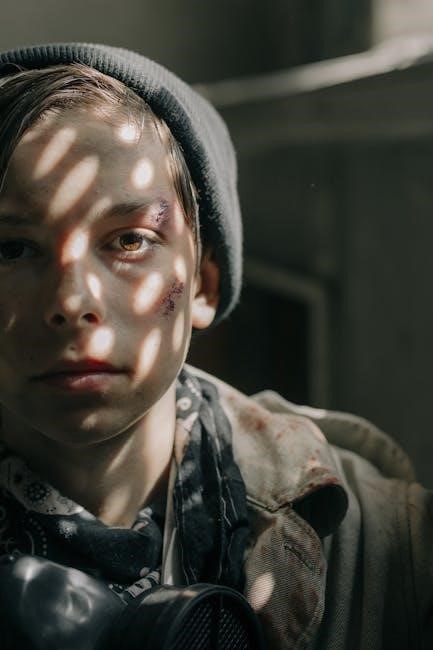
lost in space parents guide
This guide helps parents determine if Lost in Space is suitable for their children, covering content, themes, and age appropriateness for informed viewing decisions.
1.1 Overview of the Show
Lost in Space is a reboot of the 1960s series, following a family that crash-lands on an alien planet. Rated PG-13, it combines intense sci-fi action with family dynamics. The show explores survival, teamwork, and emotional depth, appealing to both parents and younger audiences. While it contains mild violence and suspenseful moments, its focus on unity and problem-solving offers positive themes. Parents should be aware of some adult content and intense scenes, making it essential to review for suitability. The series balances action and drama, making it a compelling yet thoughtful watch for families with older children.
1.2 Importance of a Parents Guide
A parents guide is crucial for evaluating Lost in Space’s suitability for children. It provides insights into content, themes, and age-appropriateness, ensuring informed decisions. By highlighting elements like violence, mild profanity, and suggestive imagery, parents can assess potential concerns. The guide also emphasizes positive aspects, such as strong female characters and educational value, helping families balance entertainment with learning. Understanding the show’s mature themes and emotional intensity allows parents to gauge its impact on younger viewers. Ultimately, a parents guide serves as a tool to foster healthy discussions and viewing habits, ensuring children enjoy content aligned with family values and maturity levels.

Age Appropriateness
Lost in Space is rated PG-13 for intense sci-fi action and mild violence, making it suitable for teens aged 13 and older, with parental discretion advised.
2.1 MPAA Rating and What It Means
The series Lost in Space carries a PG-13 rating, indicating material that may be inappropriate for children under 13. This rating reflects mild violence, intense sci-fi action, and brief suggestive content. Parents should exercise discretion, as some scenes may be too intense for younger viewers. The rating also suggests that while the show is generally suitable for teens, certain moments could require parental guidance. The PG-13 designation aligns with the series’ balance of family-friendly themes and more mature elements, making it appropriate for older children and adolescents. This rating serves as a helpful guide for parents to decide if the content aligns with their child’s sensitivity and maturity level.
2.2 Recommended Age Group
The recommended age group for Lost in Space is generally 10 years and older, depending on a child’s sensitivity and maturity. While the show is rated PG-13, its intense action, suspense, and some thematic elements may not be suitable for younger audiences. Parents should use discretion, especially for children under 13, as certain scenes involving danger, alien creatures, and emotional stress could be overwhelming. However, for older children and teenagers, the series offers valuable lessons on teamwork, survival skills, and family unity, making it a compelling watch with parental guidance. This age recommendation balances the show’s exciting sci-fi elements with its more mature themes, ensuring a thoughtful viewing experience for young audiences.

Content Warnings
The series contains action, suspense, and some violence, with minor profanity and mature themes, warranting parental caution for younger viewers.
3.1 Violence and Gore
3.2 Sex and Nudity
3.3 Profanity
3.4 Alcohol, Drugs, and Smoking

Thematic Elements
The series explores themes of family unity, survival, and problem-solving, emphasizing teamwork and resourcefulness. It also delves into mature themes like leadership and sacrifice, with emotional intensity.
4.1 Family Unity and Teamwork
In Lost in Space, the Robinson family’s survival hinges on their ability to work together and support one another. The show highlights the importance of family unity as they face countless challenges on an alien planet. Each family member, including parents John and Maureen, and their children Judy, Penny, and Will, contributes uniquely to their survival. The series emphasizes teamwork as they collaborate to build shelter, solve complex problems, and overcome life-threatening situations; Their bond strengthens through shared struggles, showcasing mutual respect and trust. While conflicts arise, the family consistently prioritizes unity, demonstrating how collaboration and love can overcome adversity. This theme is central to the show and provides a positive message for young viewers about the value of working together and supporting one another.
4.2 Survival Skills and Problem-Solving
Lost in Space showcases the Robinson family’s resourcefulness and ingenuity as they navigate a hostile alien environment. The series highlights survival skills such as building shelter, finding food, and managing limited resources. Characters often rely on science and creativity to overcome challenges, demonstrating practical problem-solving strategies. For instance, Will’s curiosity and bravery lead to key discoveries, while Judy’s medical skills prove crucial in emergencies. These elements not only drive the plot but also provide educational value, encouraging young viewers to think critically and approach obstacles with determination. The show’s focus on resilience and adaptability makes it a compelling watch for families, offering lessons in perseverance and innovation.
4.3 Mature Themes
Lost in Space tackles several mature themes that may require parental discretion. The series explores complex emotional struggles, such as grief, betrayal, and sacrifice, which are central to the characters’ development. Themes of survival and morality are often intertwined, with characters facing difficult ethical decisions. Additionally, the show delves into the psychological effects of isolation and the pressures of leadership. While these themes are presented thoughtfully, they may be emotionally intense for younger viewers. Parents should be prepared to discuss these topics with their children, as they provide valuable opportunities for conversations about responsibility, trust, and resilience. The show’s handling of these themes is nuanced, making it suitable for older children and teens who can grasp the deeper meanings.
4.4 Emotional Intensity
Lost in Space features emotionally intense moments that may resonate deeply with viewers. The series explores suspenseful and dramatic scenarios, including life-threatening situations, fear, and betrayal. Characters often face moral dilemmas and emotional strain, which can be overwhelming for younger audiences. The show’s tense atmosphere, coupled with the stakes of survival, creates a sense of urgency that may be unsettling for some children. Additionally, the emotional consequences of the characters’ decisions add depth to the story but could be challenging for younger viewers to process. Parents should be mindful of these elements, as they may require post-episode discussions to help children navigate the emotions evoked by the show’s gripping narrative.

Positive Aspects for Children
Lost in Space offers inspiring and educational content for kids, promoting STEM learning, teamwork, and resilience. Strong characters and problem-solving encourage critical thinking and curiosity in young viewers.
5.1 Strong Female Characters
Lost in Space features inspiring female characters who play pivotal roles in the story. Maureen Robinson, the matriarch, showcases leadership, intelligence, and resilience, while her daughter Penny demonstrates resourcefulness and courage. These characters challenge stereotypes, proving women can excel in STEM fields and lead under pressure. Their portrayals encourage young girls to embrace their potential and pursue ambitious goals. The strong female presence in the series promotes gender equality and highlights the importance of women in leadership roles, making it a positive influence for children.
5.2 Diversity and Representation
Lost in Space champions diversity and representation, offering a cast of characters from varied backgrounds. The Robinson family, while traditionally portrayed, interacts with a multicultural group of survivors, reflecting real-world demographics. Characters like Dr. Smith and Don West add depth, showcasing different personalities and experiences. The show emphasizes teamwork across differences, highlighting how collaboration transcends individual backgrounds. This diversity is not just for inclusion; it enriches the narrative, making the story more relatable and engaging. For children, this exposure fosters empathy and understanding, promoting a global perspective. The series successfully blends diversity into its core, enhancing its appeal and educational value for young audiences.
5.3 Educational Value
Lost in Space offers significant educational value for children, blending science fiction with real-world science and problem-solving. The series often incorporates STEM concepts, such as space exploration, robotics, and engineering, making it a great tool for sparking curiosity about science and technology. Characters use logic and creativity to overcome challenges, demonstrating the importance of critical thinking. The show also highlights themes of perseverance, adaptability, and innovation, which are valuable life skills. By presenting complex ideas in an accessible way, Lost in Space encourages young viewers to engage with science and mathematics while entertaining them. This makes it a valuable watch for parents seeking content that aligns with educational goals.

Intense Sci-Fi Action
Lost in Space delivers thrilling sci-fi action with suspenseful sequences, space exploration, and alien encounters, creating an adventurous tone that captivates viewers while maintaining a balance of drama and excitement.
6.1 Action Sequences
The show features dynamic and thrilling action sequences, including spacecraft battles, alien encounters, and intense survival situations. These scenes are fast-paced and visually engaging, with a focus on suspense and danger. While the action is exciting, it avoids excessive gore or graphic violence, making it suitable for younger audiences. The sequences often highlight the characters’ resourcefulness and teamwork, emphasizing problem-solving under pressure. Parents should note that some scenes may be emotionally intense, especially those involving life-threatening scenarios or confrontations with mysterious creatures. However, the balance between action and character development ensures that the sequences contribute to the story’s progression without overwhelming younger viewers.
6.2 Suspenseful Moments
The series incorporates numerous suspenseful moments that keep viewers engaged, often involving tense survival situations, mysterious alien encounters, and unexpected plot twists. These scenes are designed to create a sense of urgency and unease, with eerie soundtracks and vivid visuals amplifying the tension. While not excessively graphic, some moments may be unsettling for younger or sensitive viewers, particularly those involving isolation, danger, or the unknown. Parents should be aware that these suspenseful elements are integral to the show’s narrative, enhancing the sci-fi atmosphere and emotional depth. However, they are balanced with resolution, ensuring the suspense serves the story rather than overwhelming the audience.

Suggestive Content
The series occasionally features subtle suggestive imagery and dialogue, though it remains tasteful and not overtly explicit, ensuring it stays appropriate for most mature younger viewers.
7.1 Suggestive Imagery
Lost in Space includes minimal suggestive imagery, primarily through subtle character expressions or brief scenes that imply adult themes without explicit content. These moments are rare and understated, often overshadowed by the show’s sci-fi and family-driven narrative. While they may not be overtly inappropriate, parents should be aware that certain scenes might prompt discussions about maturity and context. The imagery is not graphic or prolonged, ensuring the series remains accessible to a younger audience while maintaining a balance for older viewers. The show’s focus on adventure and survival limits the emphasis on suggestive content, making it manageable for most families with older children.
7.2 Innuendos
Lost in Space contains minimal innuendos, as the series primarily focuses on family dynamics and sci-fi adventure. However, there are occasional subtle hints of adult humor or double entendres, mostly in dialogue between characters. These moments are not explicit or overly suggestive, often slipping past younger viewers unnoticed. While they are rare, parents may want to be mindful of these instances, especially if their children are highly perceptive. The show balances these elements carefully, ensuring they do not overshadow the overarching themes of survival and teamwork. Overall, the innuendos are mild and unlikely to be a major concern for most families, though parental discretion is advised for younger or more sensitive children.

Language and Profanity
The series features occasional mild profanity, but it is not frequent or explicit. Stronger language is rare, making it generally suitable for younger audiences with parental guidance.
8.1 Mild Profanity
The series occasionally includes mild profanity, but it is not excessive or explicit. Characters may use terms like “damn” or “hell” in moments of stress or frustration. These instances are rare and not central to the storyline, making the show relatively tame in this regard. The language is generally appropriate for younger audiences, though parental discretion is advised for sensitive children. The mild profanity does not overshadow the show’s overall themes of family and survival. It is brief and contextually relevant, ensuring the content remains accessible to a broad age range without compromising its appeal to older viewers.
8.2 Context of Language Use
The language in Lost in Space is used sparingly and primarily in moments of high tension or stress. Characters may utter mild profanity like “damn” or “hell” when facing life-threatening situations or expressing frustration. These instances are not frequent and are often tied to the emotional intensity of the scene. The show avoids using language for shock value, ensuring it feels natural to the characters’ experiences. While the profanity is mild, it still reflects the realistic reactions of individuals in dire circumstances. Parents should consider their child’s sensitivity to such language, though it is not a dominant feature of the series. The context often justifies the language, making it less likely to be seen as inappropriate or offensive.
Scary Moments
The series features intense and suspenseful scenes, including encounters with terrifying alien creatures, which may be frightening for younger viewers. These moments are balanced with adventure elements;
9.1 Alien Creatures
The show features unsettling alien creatures that can be particularly frightening for younger audiences. These beings are often mysterious, with eerie appearances and unpredictable behaviors, adding to the suspense. Their presence heightens tension, especially in scenes where characters are in peril. While the creatures serve a narrative purpose, their unsettling nature may cause distress for sensitive viewers. Parents should be cautious, as some sequences involving these aliens are intense and visually striking, potentially leading to nightmares for children. The combination of their menacing visuals and the unknown dangers they pose makes them a significant concern for younger viewers.
9.2 Intense Scenes
Lost in Space contains intense scenes that may be overwhelming for younger viewers. These moments often involve life-threatening situations, narrow escapes, and high-stakes dilemmas, which heighten the show’s suspense. While the series avoids excessive gore, the emotional tension and peril faced by the characters can be distressing. Scenes featuring spaceship malfunctions, alien encounters, and survival challenges are particularly poignant. Parents should be aware that these intense sequences might evoke strong reactions in sensitive children. The show’s dramatic pacing and heartfelt moments amplify the emotional impact, making it crucial for adults to gauge their child’s sensitivity before allowing them to watch. These scenes are integral to the story but warrant parental discretion for younger audiences.

Overall Tone
The show blends action, drama, and suspense, creating a thrilling yet emotional narrative. Its hopeful undertones balance intense moments, making it engaging for both teens and adults.

10.1 Balancing Action and Drama
“Lost in Space” masterfully blends thrilling action sequences with heartfelt dramatic moments, creating a dynamic viewing experience. The show’s pacing ensures that intense sci-fi action is complemented by emotional character development, allowing audiences to connect with the characters’ struggles and relationships. This balance is crucial for maintaining engagement, as it caters to both fans of fast-paced adventures and those who appreciate deeper storytelling. The mix of suspenseful space exploration and personal growth makes the series appealing to a wide range of viewers, including younger audiences and adults seeking a compelling narrative.
10.2 Suitability for Younger Audiences
“Lost in Space” is rated PG, making it generally suitable for younger audiences, though parental discretion is advised. The show’s blend of adventure and family dynamics appeals to children, but some scenes may be too intense for very young viewers. While the series promotes positive themes like teamwork and resilience, it includes moments of peril and emotional tension that could unsettle sensitive children. Parents should consider their child’s maturity level before allowing them to watch. The show’s content is appropriate for children aged 10 and above, depending on individual sensitivity. Supervised viewing is recommended to address any concerns and foster meaningful discussions about the themes and situations portrayed.
Lost in Space is a thrilling yet family-friendly series with positive themes, but parental guidance is recommended for younger viewers due to intense scenes and PG rating.
11.1 Summary of Key Points
Lost in Space is a sci-fi adventure that balances action, drama, and family themes, making it engaging for both children and adults. With a PG rating, it’s suitable for teens and older kids, though parental discretion is advised due to intense scenes and mild suggestive content. The show promotes positive values like teamwork, resilience, and diversity, while strong female characters inspire young viewers. However, the presence of violence, mild profanity, and frightening alien creatures may require guidance for younger or sensitive children. Overall, it’s a compelling series with educational and emotional depth, offering a thrilling yet meaningful experience for families.
11.2 Final Recommendation
Lost in Space is a captivating series that blends adventure, drama, and family-oriented themes, making it a great choice for older children and teens. While it offers positive messages about resilience, teamwork, and diversity, parents should exercise discretion due to intense action sequences, mild profanity, and suggestive content. For younger or sensitive viewers, co-viewing is recommended to address any concerns. Overall, the show is an excellent option for children aged 10 and above, providing both entertainment and opportunities for meaningful discussions about its themes and moral dilemmas. With proper guidance, it can be a valuable and enjoyable watch for families.